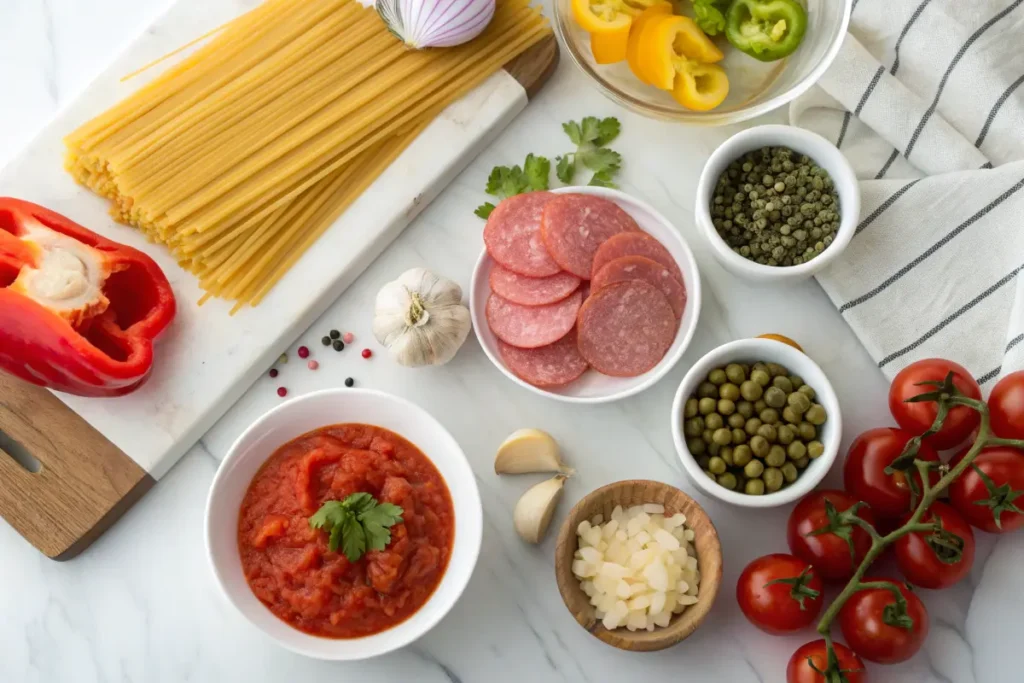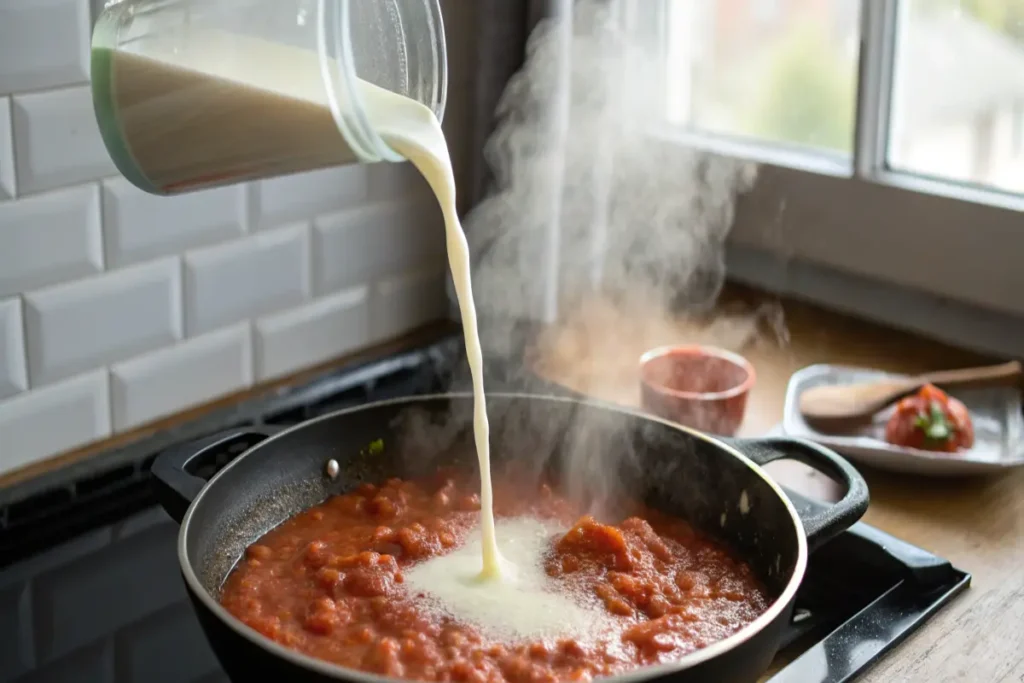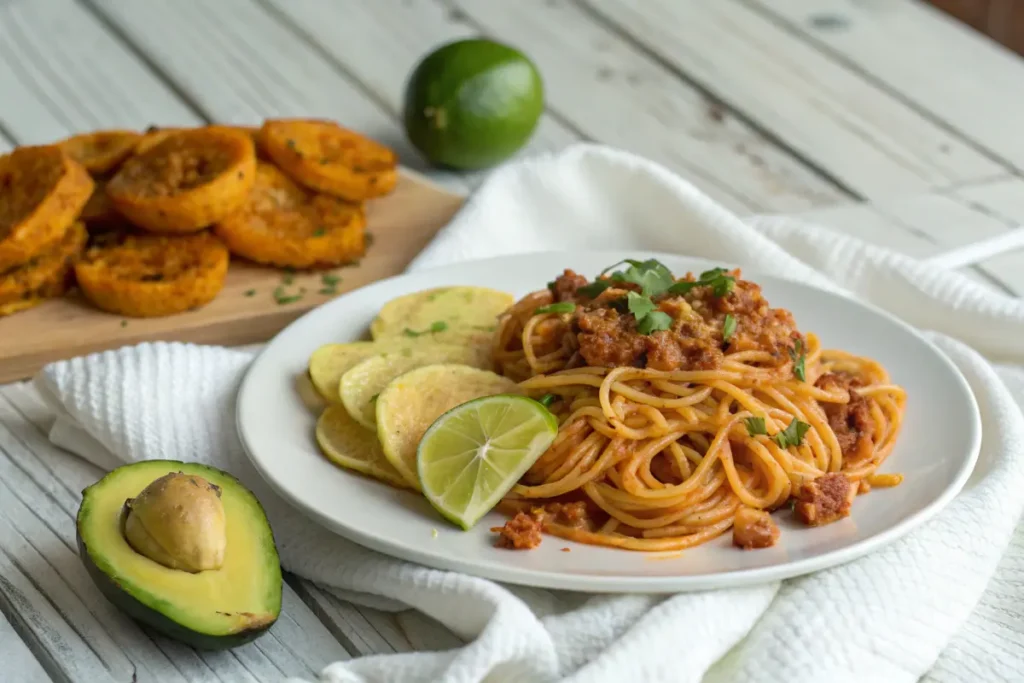Dominican Spaghetti The Amazing 1-Pot Secret to Bold Flavor
A comforting, saucy dish packed with Dominican tradition—perfect for weeknights, gatherings, or beachside bites.
Dominican spaghetti was one of the first dishes I ever learned to cook—mostly because it’s nearly impossible to mess up and wildly satisfying. The rich tomato sauce, salty salami, and briny olives come together in a way that feels like home on a plate. Honestly, it’s the kind of dish that brings people running to the kitchen before the table’s even set.
If you’re someone who loves easy, flavorful meals with minimal cleanup, this one’s got your name written all over it. It’s also a lifesaver for busy families, meal preppers, and anyone feeding a crowd on a budget.
In this recipe, you’ll learn the exact steps to master this Dominican classic—from the ingredients that give it depth, to clever ways to prep it ahead or customize it to your taste. Whether you’re a seasoned cook or just dipping your toes into Caribbean flavors, this unforgettable dish will quickly earn a spot in your weekly rotation.
Ingredient Breakdown
Here’s everything you need to make a pot of bold, flavor-packed Dominican spaghetti. Most items are pantry staples, but a few specialty ingredients make all the difference.
- 1 lb spaghetti – Traditional works best, but penne or linguine can be subbed. Cook al dente.
- 2 tablespoons olive oil – For sautéing and building depth.
- 8 oz Dominican salami, diced – Try brands like Induveca or Campesino. Smoked sausage is a decent substitute.
- 1 medium onion, finely chopped – Red or white onion both work.
- 1 bell pepper, diced – Use green for a more traditional taste, or mix red and yellow for color.
- 3 garlic cloves, minced – Fresh is best, but jarred works in a pinch.
- 1 plum tomato, chopped – Adds natural sweetness and freshness.
- 2 tablespoons tomato paste – Helps thicken the sauce.
- 1 cup tomato sauce – Use plain, no added sugar.
- 2 tablespoons olives, sliced – Spanish or alcaparrado style.
- 1 tablespoon capers – Optional but great for briny depth.
- 1 chicken bouillon cube – Or 1 teaspoon powdered bouillon.
- ½ teaspoon dried oregano – Dominican oregano if available.
- ¼ teaspoon black pepper – Adjust to taste.
- ¼ cup evaporated milk – Adds creaminess. Omit for a dairy-free version.
- ½ cup reserved pasta water – Helps bring the sauce together.
- 1 tablespoon butter – Adds gloss and richness at the end.

Optional Add-ins:
- Grated Parmesan cheese – For serving.
- Chopped cilantro or parsley – Adds brightness.
- Queso frito or tostones – Serve on the side for full Dominican experience.
Step-by-Step Instructions
Follow these steps to create the perfect pot of creamy, savory Dominican spaghetti. Keep your ingredients close—you’ll be layering flavors as you go.
Prep
- Boil the pasta.
Fill a large pot with water, add 1 tablespoon of salt, and bring it to a boil. Cook the spaghetti until just al dente—usually one minute less than the package says. Reserve about ½ cup of pasta water before draining. Set pasta aside. - Chop your ingredients.
While the pasta cooks, dice the onion, pepper, tomato, and salami. Mince the garlic and slice the olives.
Cooking Steps
3. Brown the salami.
In a large skillet or sauté pan, heat the olive oil over medium heat. Add the diced salami and cook for about 5 minutes, stirring often. It should be browned and crisp around the edges.

4. Sauté the vegetables.
Lower the heat to medium-low. Add the onions and bell pepper to the pan. Cook for 3–4 minutes until softened. Next, stir in the garlic and cook for another 30 seconds until fragrant.
5. Add tomato base.
Toss in the chopped tomato, tomato paste, and tomato sauce. Mix everything well. Simmer for 2–3 minutes until the tomatoes start to break down and the sauce thickens.
6. Build the flavor.
Stir in the chicken bouillon, oregano, black pepper, olives, and capers. Let everything simmer together for another 2–3 minutes. If the sauce gets too thick, add a splash of pasta water.
7. Cream it up.
Slowly pour in the evaporated milk, stirring constantly. This will smooth out the sauce and give it that signature creamy texture. Simmer for 2 more minutes to meld flavors.

8. Bring it all together.
Add the drained spaghetti to the sauce. Toss gently but thoroughly until all noodles are coated. If needed, add a bit more reserved pasta water to loosen the sauce.
Final Assembly
- Finish with butter.
Add the butter and gently fold it in until melted. This adds a beautiful sheen and rich finish. - Serve hot or beach-ready.
Dish it out immediately, or let it cool and pack it for a day trip. It’s just as good cold!
That’s it—classic Dominican spaghetti with all the right flavor moves. Up next: how to serve it with the best sides.
Nutrition Facts
When prepared as listed, this Dominican spaghetti recipe serves about 6 people. Below is an estimated nutritional breakdown per serving. Keep in mind that variations like using less salami or skipping the evaporated milk can lower the fat and sodium content.
While this dish isn’t keto or gluten-free by default, it can be adapted. Swap regular spaghetti for chickpea pasta or a gluten-free variety, and you’ll reduce carbs while still enjoying the dish. For dairy-free versions, simply skip the evaporated milk or use oat cream instead.
Pro Tips / Variations
Common Mistakes to Avoid
Don’t overcook the spaghetti.
It’s easy to forget, but slightly undercooked pasta will absorb the sauce better and hold its texture.
Avoid adding the evaporated milk too early.
If it goes in before simmering the sauce, it may curdle. Always stir it in last for a creamy finish.
Don’t skip the olives and capers unless necessary.
They might seem optional, but they’re key to creating the authentic salty-briny undertone of Dominican-style pasta.
Time-Saving Hacks for Busy Cooks
- Use pre-diced frozen peppers and onions to cut down on prep time.
- Pre-mix your spices into a small bowl so you can dump them in all at once.
- If you’re short on time, go with a jarred sofrito like Loisa’s Sofrito Rojo—it’s a flavorful shortcut.
- Make the sauce ahead and refrigerate for up to 3 days; just reheat and toss with fresh pasta.
Flavor Boosts & Creative Swaps
Want more heat?
Add crushed red pepper flakes or a bit of diced jalapeño during the sauté step.
Making it vegetarian?
Skip the salami and try mushrooms, eggplant, or even lentils for a hearty bite.
Trying to cut calories?
Halve the salami and skip the butter at the end. You’ll still get plenty of flavor from the sautéed veggies and tomato base.
Need a dairy-free version?
Use a splash of oat cream or almond cooking milk in place of evaporated milk. Or leave it out altogether for a lighter finish.
Add a Dominican twist.
Fold in fried queso frito cubes or sliced longaniza sausage at the very end for a bold island-style upgrade.
Serving Suggestions & Pairings
Dominican spaghetti is satisfying all on its own, but pairing it with the right sides can elevate the entire experience. Whether you’re plating it for dinner or packing it for a beach trip, here are some serving ideas to make it shine.
Classic Dominican Sides
Tostones (twice-fried plantains):
Crunchy, salty, and the perfect balance to the richness of the pasta. Serve them hot and sprinkle a pinch of garlic salt for extra flavor.
Pan de Agua (Dominican bread):
Perfect for sopping up leftover sauce. Slightly crisp on the outside, soft on the inside—it’s a staple for a reason.
Avocado slices:
Fresh and creamy, they cut through the acidity of the tomato base while adding color to your plate.
White rice:
Yes, rice and pasta together! This double-carb combo might sound unusual, but it’s deeply traditional and ultra-filling.
Green salad with lime vinaigrette:
The tangy brightness of a citrus-dressed salad provides a crisp contrast to the rich, stewed sauce.
Plating Tips
- Plate your pasta in a wide, shallow bowl so the sauce coats evenly and doesn’t pool.
- Garnish with fresh herbs or crumbled queso fresco for a little pop of color and creaminess.
- A wedge of lime on the side offers a zesty finishing touch for those who want to brighten up each bite.
Leftover Magic
Got leftovers? Great news—Dominican spaghetti tastes even better the next day.
- Reheat gently in a nonstick pan with a splash of water or milk to revive the creaminess.
- Stuff it into a sandwich roll with melted cheese for a Caribbean-style “espaguetis sandwich.”
- Serve cold as a pasta salad base and top with grilled chicken or shrimp.

Up next, we’ll cover the fascinating history and frequently asked questions surrounding this unforgettable Dominican dish.
Why You’ll Love This Recipe
There’s a reason Dominican spaghetti is more than just a comfort meal—it’s a cultural staple with deep roots and big flavor. Here’s why you’ll be making it on repeat:
- Easy, budget-friendly prep. You only need one pan and basic ingredients to create a full-flavored meal that feeds a crowd.
- Big, bold flavor. Between the sautéed salami, creamy tomato sauce, and briny olives, every bite delivers layers of richness.
- Flexible and customizable. Whether you’re feeding picky eaters or sticking to a vegetarian plan, this recipe adjusts easily.
- Meal-prep friendly. It stores and reheats beautifully, making it ideal for leftovers or next-day lunches.
- A recipe with soul. I grew up watching my mother make it on weekends. It always felt like a celebration—even if we were just eating on the porch.
FAQ
Where did Dominican spaghetti come from?
Dominican spaghetti has its roots in Italian cuisine but evolved as Dominicans adapted pasta to local tastes. It’s often linked to family gatherings, especially at the beach, and has become a dish full of both flavor and nostalgia.
What is espaguetis made of?
Espaguetis is made with pasta, a tomato-based sauce, and traditional add-ins like Dominican salami, onions, peppers, olives, and sometimes evaporated milk. The ingredients vary slightly across households, but the bold flavor stays consistent.
Is penne or spaghetti healthier?
Both are similar nutritionally, though whole wheat versions offer more fiber. In terms of authenticity, spaghetti is preferred in Dominican recipes. However, penne works fine if you want a different texture or what’s on hand.
Why do Dominicans eat spaghetti with rice or tostones?
It’s all about comfort and satisfaction. Dominicans love combining carbs—spaghetti with rice or plantains makes the meal heartier. It’s a tradition that reflects abundance and a deep love of flavorful food combinations.
Whether you’re looking for a cozy weeknight dinner, a party dish that feeds plenty, or just craving a taste of island-style comfort, Dominican spaghetti checks all the boxes. It’s bold, satisfying, and rooted in generations of tradition.
From its creamy tomato base to its unexpected pairings like rice or tostones, this dish isn’t just about the food—it’s about the feeling it brings to the table. And that feeling is pure joy.
If you loved this recipe or tried your own twist on it, don’t hesitate to drop a comment or check out more of meal ideas visit our collection. There’s a whole world of flavor waiting for you.

